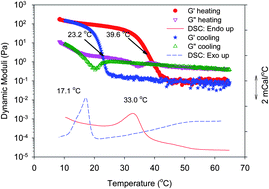Micro-DSC, rheological and NMR investigations of the gelation of gallic acid and xyloglucan
Abstract
A novel thermoreversible gelling system consisting of tamarind seed

* Corresponding authors
a
Drug Delivery System Excellence Center and Department of Pharmaceutical Chemistry, Faculty of Pharmaceutical Sciences, Prince of Songkla University, Hat Yai, Songkhla, 90112 Thailand
E-mail:
vimon.t@psu.ac.th
b School of Mechanical and Aerospace Engineering, Nanyang Technological University, 50 Nanyang Avenue, Singapore
c Soft Materials Laboratory, Natural Sciences and Science Education, National Institute of Education, Nanyang Technological University, 1-Nanyang Walk, 637616 Singapore
A novel thermoreversible gelling system consisting of tamarind seed

 Please wait while we load your content...
Something went wrong. Try again?
Please wait while we load your content...
Something went wrong. Try again?
N. Hirun, H. Bao, L. Li, G. R. Deen and V. Tantishaiyakul, Soft Matter, 2012, 8, 7258 DOI: 10.1039/C2SM25056J
To request permission to reproduce material from this article, please go to the Copyright Clearance Center request page.
If you are an author contributing to an RSC publication, you do not need to request permission provided correct acknowledgement is given.
If you are the author of this article, you do not need to request permission to reproduce figures and diagrams provided correct acknowledgement is given. If you want to reproduce the whole article in a third-party publication (excluding your thesis/dissertation for which permission is not required) please go to the Copyright Clearance Center request page.
Read more about how to correctly acknowledge RSC content.
 Fetching data from CrossRef.
Fetching data from CrossRef.
This may take some time to load.
Loading related content
